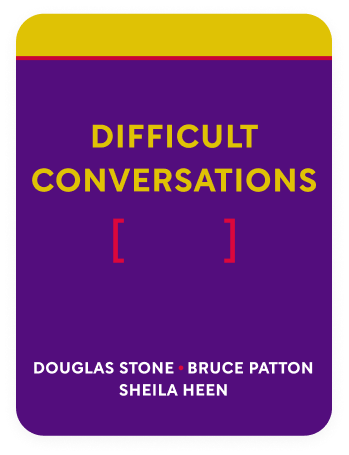

This article is an excerpt from the Shortform book guide to "Difficult Conversations" by Douglas Stone, Bruce Patton, Sheila Heen. Shortform has the world's best summaries and analyses of books you should be reading.
Like this article? Sign up for a free trial here .
Are you afraid to ask for a raise or fire one of your employees? Do you avoid talking about certain things?
Difficult conversations are a constant throughout life—at work, at home, and in the world. We never outgrow them, get a promotion that saves us from them, or meet a person who’s so perfect for us that we never have to have them.
See how the following Difficult Conversations exercises can help you successfully navigate the tough talks you need to have.
Difficult Conversations Exercises
Difficult conversations, if we engage in them successfully, are the mark of a healthy relationship. In fact, the success and survival of any relationship, business or personal, depends on the ability of those involved to master difficult conversations. Douglas Stone’s Difficult Conversations will help you ask for that raise, bring up issues with your spouse, understand your kids better, and get to the bottom of your feud with your neighbor.
Go through these four Difficult Conversations exercises individually or with a group to apply the book’s principles to your life.
Exercise #1: Practicing the Contribution System
Here are some questions you can ask yourself to help you take a more balanced approach to contribution. You can return to this exercise whenever a difficult issue arises.
- Pick a current issue you have with someone in your life, such as a partner, a friend, your boss, or a colleague. Briefly summarize the issue from your own perspective.
- List out three to five ways that you feel the other person is contributing to the issue.
- Now, list the same number of ways that you might be contributing to the issue.
Exercise #2: Discovering Your Emotional Footprint
Use this exercise to help you home in on your own personal emotional footprint by starting to understand your family’s footprint and how it affects your present emotional footprint.
- Our families play a large part in shaping our emotional footprint. Which feelings were openly discussed in your family? Another way to think of this question is what emotion words (angry, sad, happy, disappointed) did you hear your parents openly use?
- On the opposite end of the spectrum, which emotions were never discussed in your household? How did people deal with them, from your perspective?
- What emotions do you feel comfortable identifying now? Is this answer similar to or different from your answer to the first question?
- What emotions are you uncomfortable feeling or identifying? How do you deal with these uncomfortable emotions?
Exercise #3: Separating Intention From Impact
Use this exercise to practice separating someone else’s intentions from the impact their behavior had on you, either by reflecting on a past issue or working through a current one.
- Think of an issue you had with someone else in the past or one you’re currently experiencing. First, write down the actions the other person took. What did they actually say or do that led to the issue?
- Now that you’ve written out their actions, turn inward. What was the impact of their actions? How did their actions make you feel?
- How did the impact affect your assumptions? We often jump to conclusions in these situations—“he hurt my feelings, so he must not care about me”—and make assumptions based on how things affect us. What assumptions did you make in response to the impact?
Exercise #4: Navigating the Three Conversations
Remember, it’s helpful to do some work on your own before heading into a difficult conversation. Use this exercise to help you work through a past or present issue—and come back to it anytime you find yourself approaching a difficult conversation.
- We often only focus on our own perspective in a difficult conversation, when the more productive way to go into them is from the Third Story. Think of an issue you’re having currently or have had in the past. Instead of writing down your POV, do your best to summarize the Third Story perspective on the issue (refer to Chapter 14 for how to do that).
- Next, focus on the Contribution System. List the ways that you have contributed to this issue, then list the ways that you feel the other person has contributed (refer to Chapter 6 for reminders on the contribution system).
- Difficult conversations bring up feelings that we may or may not be comfortable with. What feelings has this issue brought up for you? Try to write down the obvious feelings and also the less obvious feelings that may be lurking beneath the surface (refer to Chapter 8 for help sorting your feelings).
- Finally, how does this issue impact your Identity Conversation? What facets of your identity are at stake in this issue? Why are those facets important to you?

———End of Preview———
Like what you just read? Read the rest of the world's best book summary and analysis of Douglas Stone, Bruce Patton, Sheila Heen's "Difficult Conversations" at Shortform .
Here's what you'll find in our full Difficult Conversations summary :
- Why healthy relationships need difficult conversations
- The 3 conversations that happen within each difficult conversation
- How difficult conversations go wrong and what to do about it






